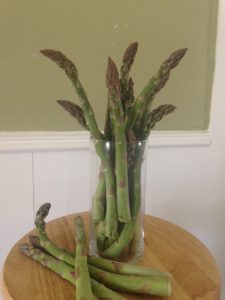 It’s one of the first and most beloved signs that the growing season has begun– bright green spears of asparagus reaching up to the sky in triumph over the long winter. Their season is fleeting and the demand quite high, so how can you make the most of asparagus while it lasts?
It’s one of the first and most beloved signs that the growing season has begun– bright green spears of asparagus reaching up to the sky in triumph over the long winter. Their season is fleeting and the demand quite high, so how can you make the most of asparagus while it lasts?
Asparagus is a great source of vitamins A-C and also rich in minerals such as potassium and zinc. It is naturally fat-free with a low calorie count for those looking to reduce their intake. To store, wrap in a damp cloth in the vegetable drawer of the fridge, or stand in a vase with one-inch water, also refrigerated.
Usually, simpler is better with the asparagus spear! It can be steamed, grilled, roasted or sauteed (whole or cut) until bright green with minimal add-ons such as salt and pepper, butter, parmesan cheese, lemon juice, or cream/hollandaise inspired sauces. It makes a great stand-alone side or easily mixes in to pasta and grain dishes.
Here are my two favorite ways to use asparagus:
Asparagus Brunch
Assemble enough asparagus for your gathering- approximately 5 to 8 spears per person. Trim woody ends and prepare asparagus as you wish (steamed, roasted or sauteed until a bright and tender green). Top with poached or soft boiled eggs, two per person, and dust with salt and pepper. Consider adding toppings such as shallots, scallions, pickled red onion, parsley or basil. Break the yolks over asparagus just before serving.
Asparagus Pesto
My new obsession this asparagus season! I have used two different recipes, both with success. Originally, this pesto was meant as a sauce for pasta (reserve tips for including in pasta and dilute pesto with a touch of pasta water), but I have been enjoying it as a pizza sauce and on sliced fresh bread from McKenzie’s Farmstand.
- Several spears asparagus (a good bunch, maybe 4- 8 spears depending on size)
- one handful grated parmesan cheese
- 2 tsp (approx) olive oil
- pine nuts (optional)
- 2 scallions or one shallot (optional)
- 1-2 tsp lemon juice and zest
- 2 garlic cloves
Roughly chop the asparagus, garlic and scallions/shallot. This is a good opportunity to use less desirable asparagus stalks– ones that are a bit large, slightly woody, becoming limp or are otherwise imperfect. Reserve the tips for another use, such as in pasta. Some recipes call for cooking the asparagus, but I used mine raw both for convenience and for maximum nutritional benefit. Combine in a food processor with the pine nuts until very fine. Add lemon juice and olive oil by sight, a little at a time, until the pesto is the consistency you prefer. Mix in the cheese and lemon zest, as well as a few sprinkles of salt and pepper to taste.
Pine nuts can be expensive and difficult to find, plus it can be limiting to an audience that has nut allergies. I happen to have preferred the nut-free version because it was a bit creamier and had a fresher taste. Including pine nuts means you will use somewhat more olive oil and lemon juice to get a good consistency. This pesto is open to experimentation– add and subtract ingredients at will to find your favorite rendition!
